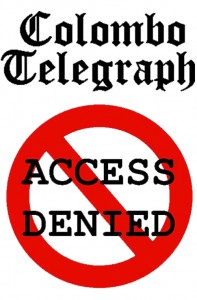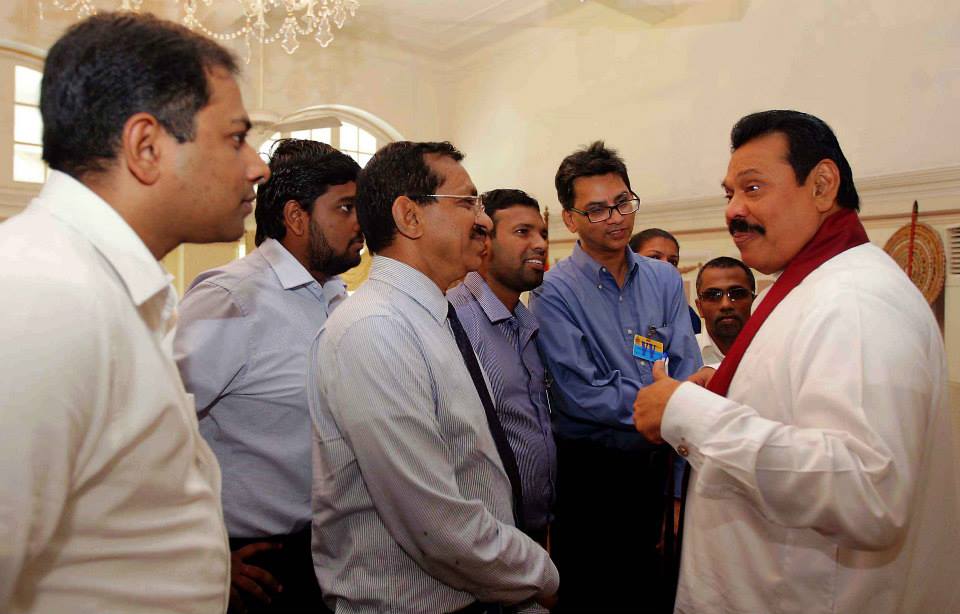By Izeth Hussain-February 28, 2014, 8:53 pm

What are ethnic problems about? Almost invariably they are about discrimination. Sometimes ethnic groups claim the right to establish a separate state on the principle of self-determination and that is the source of some ethnic problems. But for the most part even they are willing to forego the claim to a separate state if they are given fair and equal treatment – that is, if they are not subjected to discrimination.
So, discrimination is of the very essence of ethnic problems. But there is a curious lacuna in the terminology used in ethnic discourse. In the act of discrimination x is the subject who discriminates against y who is the object of discrimination. What is the term to designate x? There is no such term as "ethnicist" unlike the term "racist" in the discourse of racism. Therefore ethnic discourse neatly elides away what is at the very core of ethnic problems: discrimination. That suits the purposes of majoritarian racists.
Also revealing is the discourse on national identity. From 1989 to 1994 I participated in several seminars on national identity, and I even presented papers at a couple of them. At that time the widespread assumption in the intellectual community was that the answer to the ethnic problem was to work out an authentic Sri Lankan national identity transcending our ethnic and other identities. Maybe, but how was that to be done? As far as I can recall that question was hardly ever addressed. I myself came to the notion that developing a transcendent national identity would be possible only if the minorities are given fair and equal treatment – that is if they are not discriminated against. They would then develop a sense of togetherness, of belonging, of being not just in Sri Lanka but of Sri Lanka. A scholar researching all that dreary material on national identity would probably find that it was only I, a minority member, who stressed the importance of the problem of discrimination in connection with national identity. The majority members ignored that problem. That was possible and convenient within the confines of ethnic discourse. On the other hand, the discourse of racism would bring the problem of discrimination to the forefront.
It is a curious fact that the term ‘racism’ has come into vogue in Sri Lanka in recent years, and it looks like it is in the process of replacing the earlier ubiquitous ‘communalism’. But, what is meant by ‘racism’ is not properly understood, certainly not in the way that it is very widely understood in the West. It seems to me important to bring about a proper understanding of what is meant by ‘racism’ because the paradigm of racism can enable us to handle our ethnic problems much more effectively than in the past, benefiting greatly from the vast experience gathered in the West in countering racism. The way we have handled our ethnic problems up to now has been – to put it in one precise eloquent word – idiotic.
I will not attempt to define ‘racism’ because all such political terms – for instance democracy, Fascism, terrorism and so on – can have over a hundred definitions and yet none of them will be definitive in the sense that it commands universal assent. Instead, I will provide some pointers to show how the term is understood today. The core idea is that some ethnic groups are inherently, intrinsically, essentially, enduringly, almost unchangeably inferior to others. At this point I must make a clarification. Traditionally, in the West, racism was understood to mean that some races were genetically and unchangeably inferior to others. But it came to be established that there is no such thing as a pure race, and besides it has proved impossible to establish that the inferiority of an ethnic group has been genetically determined. Therefore, ‘race’ has come to be replaced by ‘culture’ in the sociological sense, and we now have paradoxically racism without race. The important point, however, is that under modern racism some ethnic groups are seen as essentially inferior to others.
I must now explain what is meant by ‘essentialism’ as it is the key concept in race theory. This is what Pierre Andre Taguieff, one of the foremost theorists of race, has to say about it, in my literal translation: "Mode of thought which consists in attributing to all members of a group, and tendentiously to them alone, certain characteristics, explaining these by the nature or essence of the group, (by its natural dispositions) rather than by situational factors".
Certain consequences follow from the above definition; one is what has been called ‘synechdocic substitution’, by which is meant the application to the whole of what is true only of the part. For instance, I am an orthodox Sunni Muslim and I am proud of being so, in which way I am a typical SL Muslim, but at the same time I am thoroughly Westernised and some would say an intellectual, in which ways I am not a typical SL Muslim. But the racist would say that the Westernisation is bogus and being an intellectual intolerable pretentiousness and that in essence I remain a trader, cunning, unscrupulous, and all out for gain. What might be true of a part is thus being applied to the whole. All this points to another characteristic of the racist: the propensity to think in terms of stereotypes.
One of the most important characteristics of racism is irrationality, which for some reason is not given central importance in race theory. It is not an exclusive defining characteristic because non-racists can be irrational, but it is an integral part of racism that should be given central importance because of its terrifying destructive and self-destructive potential. I have pointed out in an earlier article that it is arguable that Hitler lost the Second World War because of his racist belief that the Soviet Union would very quickly cave in to a German invasion. The reason why racism and irrationality go integrally together requires investigation. I have in mind some brilliant thinking by Bertrand Russell, not on racism but on irrationality, which cannot be covered in this article because it includes some complex philosophical arguments. So, I will merely quote the following from his 1935 essay, The Ancestry of Fascism: "Rationalism and anti-rationalism have existed side by side since the beginning of Greek civiisation, and each, when it has seemed likely to become completely dominant, has always led, by reaction, to a new outburst of its opposite".
In concluding this exposition of what is meant by racism I must make an important clarification. Ethno-centric prejudice is not the same thing as racism. One of the great anthropologists of the last century, Claude Levi-Strauss, wrote that there is not a single ethnic group, even those lost in the depths of the Matto Grosso jungle, which does not believe that its way of life incarnates all the best of which human life is capable. Suspicion and a jaundiced view of the Other may be practically ubiquitous all over the world. But if that is racism, it would not be particularly objectionable because it would be seen simply as part of the human condition. But, it is seen in the contemporary world as deeply objectionable, indeed as a disease that is containable and corrigible, if not entirely ineradicable,
Racism, therefore, is not just a matter of perceiving the Other negatively. Perception has to lead to action that is inimical to the legitimate interests of the Other. Perceiving the Other as essentially inferior, or as too alien to allow positive rapport with him or as threatening and dangerous, could lead to his being discriminated against, his being excluded in various ways, and even his being subjected to genocide. Perception is, of course, important because that is what could lead to negative action.
The above is in broad outline what I have in mind by the paradigm of racism, which I hold will lead to far more effective action on our so-called ethnic problems than has been the case hitherto. We can learn a great deal from the West about action to counter racism, a field in which they have much expertise after 1945. We urgently need legislation against hate speech. We need an Equal Opportunities Bill, which in fact was mooted in the late ’nineties by Prof. G. L. Peiris but was shamefully allowed to lapse by CBK. We need the equivalents of the West’s Race Relations Boards. And so on.
I believe that what we need, above all, is to bring about a widespread awareness that it is racism that has been wrecking our ethnic relations over many decades, racism on both sides of the ethnic fence, with the Muslims relentlessly bootlicking the Sinhalese power-elite. We need the equivalents of RAT (Racism Awareness Training) programmes that are in use in some Western countries, because most Sri Lankans I believe are not even aware of their own racism. We need to be made aware that it is the essentialising habit of mind that is at the core of racism that underlies our unconscionably protracted ethnic imbroglio: the Sinhalese believe that the Tamils are essentially separatist and will use devolution only to strike out for Eelam, while the Tamils believe that the Sinhalese will never give them fair and equal treatment because of an essential and unchangeable Mahawamsa mind-set.
I will conclude this article by looking at our ethnic imbroglio through another perspective: that of tribalism and universalism. We cannot transcend tribalism and racism through counter-tribalism and counter-racism. We can do that only through universalism. In Sri Lanka the four great world religions are flourishing, which by definition as world religions transcend tribalism and racism. Furthermore, the wider ecumenism establishing common ground between the four great world religions has been much in vogue in recent decades. But, the world religions can also be used only for the affirmation of group bonds and no more than that. The example of Islam in Sri Lanka is very striking. I believe that of all the great world religions Islam is the most universalist with a deep in-built abhorrence of tribalism and racism. But, in recent decades we have seen our Muslims use Islam for the affirmation of group bonds to what looks like a pathological extent. We cannot attain universalism through our religions. Is it – a heretical thought that will drive some Sri Lankans to fury – that we can attain universalism only through Westernisation?
Izethhussain@gmail.com



 - See more at: http://onlineuthayan.com/News_More.php?id=186232683327396359#sthash.BqE9rOTC.dpuf
- See more at: http://onlineuthayan.com/News_More.php?id=186232683327396359#sthash.BqE9rOTC.dpuf








-hgw--FINAL-.jpg)


 A recent AFP commentary on the conflict, could be considered a suitable ‘kick –off’ point for a discussion of this question of the lack of public participation in foreign policy debates and discussions. Ending the commentary the reporters said: ‘So while Washington is outraged at the carnage when troops fire on protestors in Kiev – and may impose sanctions, few in Washington argue the showdown is a dominant US national interest.’
A recent AFP commentary on the conflict, could be considered a suitable ‘kick –off’ point for a discussion of this question of the lack of public participation in foreign policy debates and discussions. Ending the commentary the reporters said: ‘So while Washington is outraged at the carnage when troops fire on protestors in Kiev – and may impose sanctions, few in Washington argue the showdown is a dominant US national interest.’






